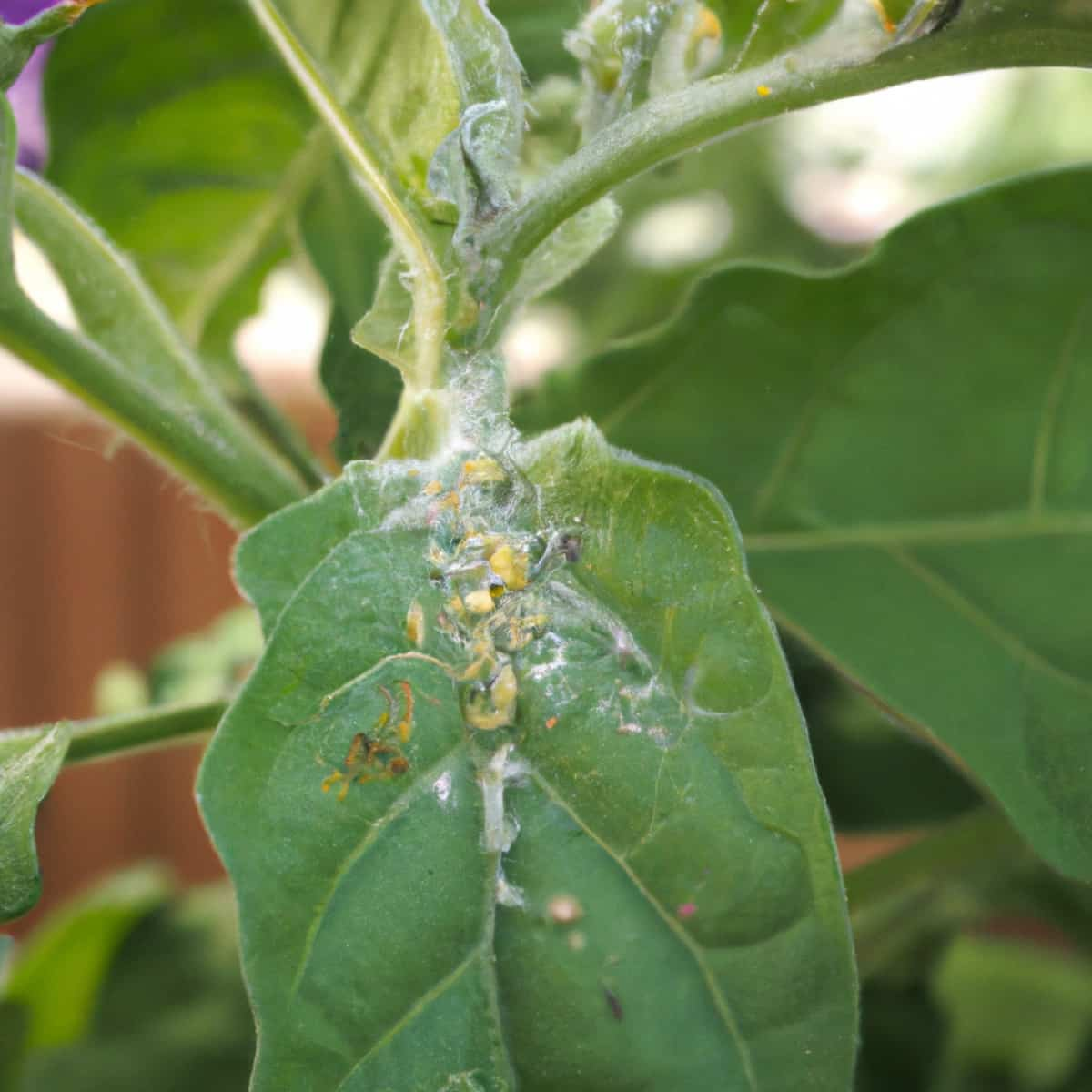Eggplants are a popular vegetable crop susceptible to various pests, including two-spotted spider mites (Tetranychus urticae). These tiny arachnids can quickly become a problem for eggplant growers, particularly after using broad-spectrum insecticides. Spider mites are known for piercing, sucking mouthparts, which they use to extract the plant’s sap, causing damage to the leaves. In hot, dry weather, their populations can increase rapidly, leading to yellow stippling on the foliage and the production of webbing.

Spider Mite Management in Eggplant
The Life Cycle of Spider Mite
- Egg stage: Spider mites lay their eggs on the undersides of leaves, often under the webbing. The eggs are tiny, spherical, and pale white. They can only be seen with a magnifying lens. Eggs hatch in 4 or 5 days.
- Larva stage: After hatching, spider mite larvae emerge. They are light green or pinkish, slightly larger than the eggs, and have six legs. Larvae feed on plant sap, which is when they cause the most damage to the plant.
- Nymph stage: The next spider mite life cycle stage is the nymph stage. Nymphs look similar to adults but are smaller. They are green or red and have eight legs. They continue to feed on plant sap during this stage.
- Adult stage: Adults are oval-shaped and have eight legs. They are tiny, usually not exceeding 0.5 mm, and can resemble tiny moving dots to the naked eye. The male is usually smaller than the female and has a more pointed abdomen. Spider mites are variable in color depending on the species, with many species being bright red, sometimes referred to as red spider mites. Others are yellowish, greenish, pinkish, orange, or reddish. The two-spotted spider mite has a large dark blotch on each side of the body. Adult spider mites continue to feed on plant sap and reproduce, starting the life cycle again.
Identification of Spider Mite in Eggplant
To identify spider mites in eggplant, look closely at the undersides of the leaves for tiny, spherical, pale-white eggs. The eggs are often found under the webbings on the leaves. After 4 or 5 days, the eggs hatch into nymphs that look similar to adults but are smaller and have only six legs. The nymphs molt three times before becoming an adult.
Depending on the species, adult spider mites are very tiny and may be yellowish, greenish, pinkish, or reddish. They have an oval body with eight legs and two red eyespots near the head. Males are smaller than females and have more pointed abdomens. A female spider mite usually has a large, dark blotch on each side with numerous bristles covering her legs and body.
Damage Symptoms of Spider Mite in Eggplant
- Spider mites can cause a range of damage symptoms on eggplant plants. The initial symptom is usually the appearance of tiny yellow spots on the leaves, which later turn into a yellow or bronze discoloration of the leaves.
- As the infestation progresses, the leaves may become stippled, as if they have been speckled with salt or pepper.
- Severe infestations can cause defoliation, leaving the plant with few or no leaves. This reduces the plant’s ability to photosynthesize and produce energy, leading to stunted growth and reduced yield.
- The plant may sometimes die if the infestation is not controlled in time.
In case you missed it: Aphids Management in Eggplant: Symptoms, Treatment, Chemical, Biological, Natural, and Organic Control

Spider Mite Management in Eggplant by Cultural method
- Avoid planting eggplant in weedy fields and close to legume forage crops, as they can harbor spider mites.
- Avoid using broad-spectrum insecticides for controlling other pests during the early season, as they may also kill beneficial predators of spider mites.
- Do not over-fertilize the plants with nitrogen, as excessive nitrogen fertilization can worsen the outbreak of spider mites.
- Overhead irrigation or prolonged periods of rain can help reduce spider mite populations by washing them off the plants. However, care should be taken to avoid creating excessively wet conditions, which can promote the growth of fungal diseases.
Spider Mite Management in Eggplant by Biological Method
- Spider Mite management in Eggplant by Biological method uses natural enemies such as predatory mites, beetles, ladybirds, lacewings, thrips, bugs, and flies to control spider mites.
- Predatory mites such as Phytoseiulus persimilis are widely used to control two-spotted spider mites and are commercially available.
- Augmentative releases of these natural enemies are required to maintain control in areas where the mites have been established.
- It is essential to avoid broad-spectrum pesticides that may harm these natural enemies.
Spider Mite Management in Eggplant by Chemical Method
- Abamectin (Agri-Mek SC, Epi-Mek): applied at 0.009 to 0.019 lb ai/A with a pre-harvest interval (PHI) of 7 days and a re-entry interval (REI) of 12 hours. A maximum of 0.056 lb ai/A should be used per season.
- Acequinocyl (Kanemite 15SC): applied at 0.3 lb ai/A with a PHI of 1 day and an REI of 12 hours. The maximum amount used per season should be 0.6 lb ai/A.
- Bifenazate (Acramite 50W): applied at 0.0375 to 0.5 lb ai/A with a PHI of 3 days and an REI of 12 hours.
- Bifenthrin (Brigade WSB): applied at 0.08 lb ai/A with a PHI of 7 days and an REI of 12 hours. A maximum of 0.2 lb ai/A can be used annually, and applications should be spaced at least seven days apart.
- Bifenthrin/avermectin (Athena): applied at 0.09 to 0.12 lb ai/A with a PHI of 7 days and an REI of 12 hours. Retreatment should occur at least ten days, and the maximum amount used per season should be at most 0.056 lb ai/A for avermectin or 0.4 lb ai/A for bifenthrin.
Spider Mite Management in Eggplant by Organic/Natural Method
Make a coriander seed extract by pounding or crushing 200 grams of coriander seeds and boiling them in 1 liter of water for 10 minutes. Let the mixture cool and strain it. Dilute the extract with 2 liters of water and use it to spray your eggplants. The coriander seed extract can help prevent fungal diseases that weaken eggplants and make them more susceptible to spider mite infestations.
In case you missed it: Flea Beetle Management in Eggplant: Symptoms, Treatment, Cultural, Chemical, Natural, and Organic Control

Make a basil leaf extract by pounding or grinding 50 grams of basil leaves and soaking them overnight in 2-3 liters of water. Add 8-12 ml of soap and stir well. This mixture can be used to spray on infected plants, particularly on the undersides of leaves where spider mites tend to congregate.
Conclusion
Managing spider mites in eggplant is crucial to maintain the health and productivity of the crop. Cultural practices like sanitation, proper irrigation, and fertilizer management can help prevent and control spider mite populations. In addition, chemical control can be used in severe cases, but it is important to follow label instructions and use insecticides responsibly. By implementing integrated pest management strategies, growers can effectively manage spider mites and minimize the impact on their eggplant crop.
- Beneficial Insects in Pest Management
- Natural Solutions for Pest Control in Flower Gardens
- Types of Fungicides Used in Agriculture
- Common Issues in the Fruit Development Stage of Pomegranate Farming
- Fruit Development Issues in Papaya: Easy Solutions and Treatment
- Soil-Borne Diseases and How to Protect Your Plants
- Practices to Prevent Disease Spread in the Garden
- From Wilted to Thriving: How to Treat Root Rot Naturally in Houseplants
- Natural Remedies to Cure Brown Spots on Fig Tree Leaves